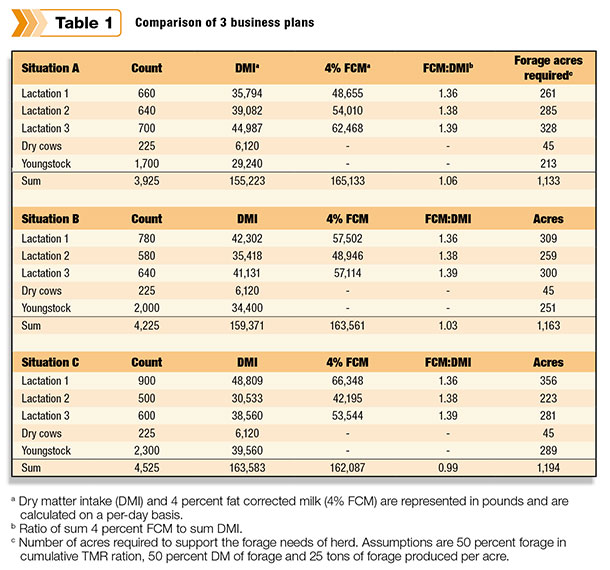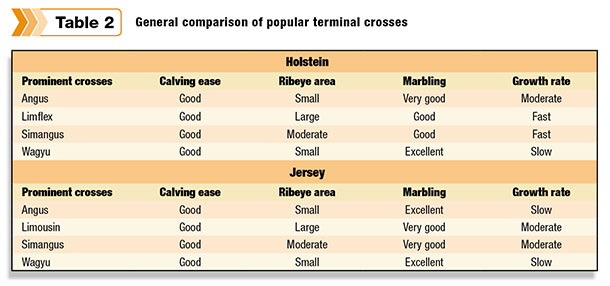You’ve asked some variation of the question, at least once, at some point in the last couple years. This is the same question everyone else in the dairy industry has asked sometime or other. The question is: “What’s up with this beef price, and how long is it going to stick around?”
If you are like many producers, you’ve either thought about or already begun to incorporate some level of beef semen usage into your dairy to take advantage of a strong market. The purpose of this article is not to forecast beef futures but to demonstrate why beef semen usage on dairies is here to stay long past the point where the beef market normalizes and eventually falls.
Your dairy operation has a finite amount of resources. Some limiting resources for your dairy might be arable acres, water, growing season, equity, cash flow – or any number of things. A common business practice is to establish a three- or five-year plan to leverage the strengths and manage the risks from the weaknesses of your operation.
The question for future business planning is not whether your operation will supply adequate replacements, but what number of replacements best suits your dairy based on the resources available.
Most dairies can produce sufficient replacements to support a 40 percent or greater cull rate without using sexed semen on heifers. This leaves plenty of room for selective breeding strategies that allow you to leverage the strengths and minimize the weaknesses of your operation.
Consider the dairy examined in Table 1. This farm plans to milk 2,000 cows without any substantial expansion over the next five years. The puzzle this dairy producer has to solve is what combination of total livestock inventory, milk production, cattle sales and land usage best suits their business. Hopefully, you find some parallels in these situations that help in planning for your operation.

Situation A
Situation A presents a scenario where the farm plans to own a minimal number of livestock. This situation enables the dairy to get the most milk out of their parlor and the most milk per pound of dry matter fed. This model is also the most demanding in that it requires excellent management to work properly.
One negative of this approach is that if an unexpected expansion opportunity did arise, the dairy would need to purchase nearly all of the newly needed cattle from outside sources.
In this scenario, the dairy would aim to cull roughly 33 percent of the cows, so the amount of beef sales from culled dairy cows would be reduced compared to the other scenarios. This situation does enable the farm to incorporate large amounts of beef semen into dairy cattle (potentially more than 60 percent beef usage on cows), and the farm can choose when to market the crossbred calves.
This approach requires the least amount of acreage, but in cases where feed availability is a strength, that same feed could easily be redirected from replacement dairy heifers to beef feeder calves or sale.
Situation B
Situation B presents a scenario where the farm plans to maintain the status quo. The dairy can target a 40 percent cull rate, produce about the same amount of milk as present and feed about the same amount of dry matter as present.
This approach does give the dairy some flexibility in that a small amount of beef semen can be used (around 20 percent usage in cows) while still being able to sell some springers or fresh cows when the opportunity arises. The beef semen usage and high cull rate keeps the heifer program manageable and prevents tying up as much cash flow into heifers as Situation C.
This situation could be considered the “safe play.” It doesn’t require as high of a management level as Situation A and allows the operation to diversify into more markets (e.g., beef crosses, cull dairy cows or springers) than the other two scenarios.
Situation C
Situation C presents a scenario where the farm produces as much dairy livestock as possible. In certain situations (Jerseys or strong heifer export area), this approach may indeed provide the most financial benefit.
The feed costs of Situation C will be the greatest, and the milk produced from Situation C will be the least.
The farm will capture the most dollars from cull dairy cows in this situation. Planning the business around large volumes of springer or fresh cow sales can certainly be risky. Even when springer prices are high, the margins tend to be slim in most parts of the country. With no expansion plan in place, this dairy doesn’t have a way to absorb these heifers into their system if that market does turn sour.
Summary
Situations A and B are both conducive to incorporating beef semen into a Holstein dairy. Any of the situations would work with a Jersey dairy, where using only sexed Jersey semen and beef semen on cows and heifers is commonplace. Once you develop a plan for your herd, you’ll have to decide which beef breed works best for you.
Table 2 can help you guide through determining which terminal beef cross works best for your situation. The concept of a terminal cross might be unfamiliar ground, but this is exactly what producers in the broiler, swine and beef industries do on a daily basis.

The dairy carcass has some highly marketable characteristics. According to the latest National Beef Quality Audit, dairy carcasses had better marbling scores than native beef cattle while equaling the native beef cattle in quality grade and yield grade.
The downside of the dairy carcass (especially true in Jerseys) is the small ribeye area. Therefore, choosing a terminal cross that will expand the ribeye area and, ideally, increase the growth rate of the resulting calves is best.
Note that the best terminal cross for dairy breeds may not be Angus, and there is nothing within the Certified Angus Beef program that requires cattle to actually have any Angus heritage.
The exception to the big ribeye and fast growth rule is the Wagyu breed. Wagyu is the breed associated with Kobe beef and fits a niche market that is largely dependent on exports. Research has shown Wagyu has the most intramuscular marbling and tenderness of any cattle breed, followed immediately by Jersey; Holsteins are not far down the list.
Since there are not many large herds of Wagyu cows roaming the U.S. (or any country for that matter), the dairy industry is the best place to find loads of comparable carcasses to purebred Wagyus.
There are risks that come from choosing Wagyu, however, because these cattle grow much slower and require more feed to gain than other options. The caution here is that Wagyu crosses must obtain a premium, or they are not commercially viable. PD
References have been omitteddue to space but are availableupon request. Click here to email an editor.

-
Colten Green
- National Account Manager
- Genex Cooperative Inc.
- Email Colten Green






